|
 Paxillus involutus Paxillus involutus
SynonymsAgaricus involutus
BiostatusPresent in region - Exotic
Images (click to enlarge)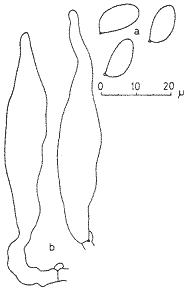
Caption: Paxillus involutus: a, spores: b, cystidia. | 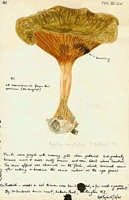
Caption: Watercolour
Owner: G.M. Taylor | 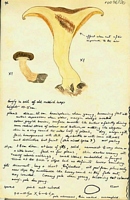
Caption: Watercolour
Owner: G.M. Taylor | 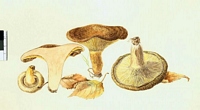
Caption: Watercolour
Owner: G.M. Taylor | 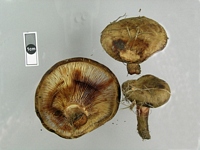
Owner: J.A. Cooper | 
Owner: P. Leonard |
Article: McNabb, R.F.R. (1969). The Paxillaceae of New Zealand. New Zealand Journal of Botany 7(4): 349-362 (http://www.rsnz.org/publish/abstracts.php).
Description: PILEUS: convex or occasionally umbonate when young, applanate, centrally depressed
or shallowly infundibuliform at maturity, 4-12 cm diam., slightly to moderately
viscid under wet conditions, otherwise dry, velutinate to subtomentose when
young, sparsely felted to subglabrous at maturity, often areolately creviced,
brownish fawn, ochraceous brown, rusty brown, or faintly olive brown, frequently
mottled and with dark reddish brown stains; cuticle a trichodermium when young,
composed of erect, filamentous hyphae with clamp connections and brown contents,
terminal cells unspecialised, 4-8.5 µm. diam., becoming disorganised at maturity
and hyphae obliquely ascending or repent; margins strongly involute and coarsely
tomentose when young, irregularly involute and sparsely felted or subglabrous
at maturity, often faintly radially sulcate when old. LAMELLAE: crowded, deeply
decurrent, meruloid or anastomosing near stipe, simple, anastomosing, or repeatedly
dichotomously branched to 3 times, often with prominent side veins, 3-7 mm deep,
dull creamy ochraceous when young, darkening to dull yellowish brown or yellowish
rusty brown at maturity, discoloured dark reddish brown where damaged, lamellulae
present, irregularly arranged. STIPE: 1.5-6 cm long, subequal or tapering basally,
occasionally expanded at extreme base, to 1.8 cm diam. apically, to 0.8 cm.
diam. basally, central or occasionally eccentric, solid, dry, tomentose, subtomentose,
or finely velutinate by presence of filamentous, clamped hyphae with brown contents,
or subglabrous, more or less concolorous with lamellae apically, brownish fawn
or sordid brown towards base, often with reddish brown tints; flesh sordid brownish
fawn, brownish yellow or pallid brown, turning faint reddish brown on exposure
to air; veil absent.
SPORES: spore print orange-brown (between Sudan Brown and Antique Brown); spore
melleous, ovate to broadly elliptical, slight suprahilar depression or applanation
occasionally present, apiculate, germ pore absent, 8.4-10.4- (12.5) X 5-6.5
µm., moderately thick-walled, smooth. HYMENIUM: basidia hyaline, clavate, 25-40-(50)X
7-10 µm., 4-spored; cystidia scattered, numerous, fusiform to ventricose-rostrate,
hyaline or with brownish walls and contents, 42-85 X 6.5-13.5 µm. HYMENOPHORAL
TRAMA: bilateral, mediostratum of slightly interwoven, longitudinal hyphae,
lateral stratum of more closely interwoven hyphae; clamp connections present.
CONTEXT OF PILEUS: sordid yellowish white to brownish white, slowly turning
reddish brown on exposure to air. SMELL and TASTE: not distinctive. CHEMICAL
CHARACTERS: KOH on pileus—dark reddish brown with purplish tints; on context—dark
purplish brown; NH4OH on pileus—darkening with reddish purple tints; on context—faint
reddish purple.
Habitat: HABITAT: Gregarious under introduced broadleaved
trees.
Notes: Paxillus involutus is widely distributed throughout temperate and warm
temperate regions of the Northern Hemisphere. The species has also been recorded
from temperate South America and Australia, but Singer (1964) considered that
it might be introduced rather than indigenous to the Southern Hemisphere. It
is not clear whether Singer and Moser (1965) regarded P. involutus as
an introduced species in Chile. However, the strict association of P. involutus
with exotic trees in Australia (Cleland, 1934) and New Zealand strongly suggests
that it is not indigenous to these two countries.
The mycorrhizal status of P. involutus is uncertain. Singer (1964) considered
it to be facultatively mycorrhizal and remarked that while it generally occurred
in the shade of trees, it did not necessarily form mycorrhizas with them. Singer
and Moser (1965) later regarded the species as transitionally mycorrhizal and
capable of living either as a mycorrhizal fungus or independently. The fact
that P. involutus occurs only in association with introduced ectotrophs
indicates that it is obligatorily mycorrhizal in this country.
P. involutus is considered edible but of inferior quality. It has been reported to cause
poisonings in Europe and it is now thought necessary to boil the fruitbodies
and discard the liquid before eating (Singer, 1962). The species has not previously
been recorded from New Zealand.
Article: Horak, E. (1980) [1979]. Paxilloid Agaricales in Australasia. Sydowia 32: 154-166.
Notes: Adventitious under Betula and Corylus in Auckland and various localities in Canterbury MCNABB 1969: 352).
|